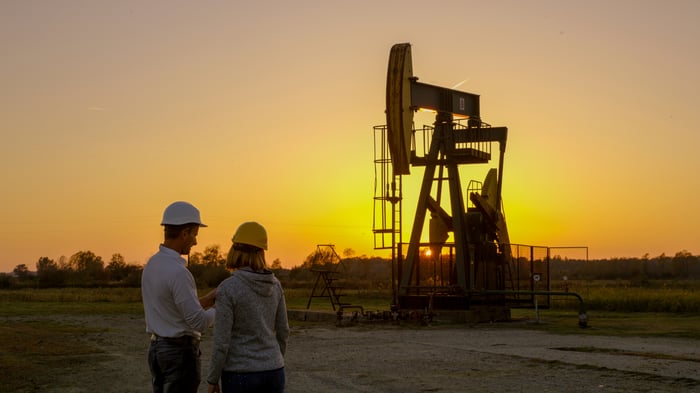Dividend investors tend to prefer boring businesses, which can lead some to overlook volatile sectors like energy. That, however, would mean missing out on stocks that could help make you richer, like energy giant Chevron (CVX 0.17%). Here's why buying Chevron today and holding through 2030, or even longer, could be a great investment decision.
The problem with energy and why you should still invest in it
Oil and natural gas are highly volatile commodities prone to dramatic and swift price moves. That, in turn, has an impact on the businesses that produce energy, like Chevron. Simply put, Chevron's top and bottom lines can swing wildly from year to year and even quarter to quarter. You need to have a strong constitution to own an energy stock.

Image source: Getty Images.
But even the most conservative investor should consider having some exposure to energy. The world is highly dependent on oil and natural gas. Even when the prices of these vital fuels are low, demand is still usually pretty robust. Even the slow shift toward cleaner energy alternatives isn't likely to end the use of oil and natural gas. Companies like Chevron provide a basic necessity of modern life.
Chevron is a great choice, particularly if you are a dividend investor. And the fact that oil prices are a bit weak today makes now a great time to jump aboard, since that fact has dampened Chevron's stock price and left it with an attractive yield of 4.3%.
Why buy Chevron today
To be fair, a deep energy downturn would provide a better entry point. But that 4.3% dividend yield compares very favorably to the 1.2% yield of the broader market and the 3.2% yield of the average energy stock. Chevron's dividend, meanwhile, has been increased annually for 38 consecutive years, a feat matched by only one other major energy company, ExxonMobil (XOM 1.75%). While Exxon's 43-year streak is longer, that company's dividend yield is a less attractive 3.5% right now.
Both of these U.S. energy giants have a similar, diversified, business model. As integrated energy companies they have exposure to the upstream (energy production), the midstream (pipelines), and the downstream (chemicals and refining). That diversification helps to soften the industry's inherent swings, since each segment operates a little differently through the energy cycle.
CVX Debt to Equity Ratio data by YCharts
On top of that, Chevron has one of the strongest balance sheets in the energy sector. Its debt-to-equity ratio, a measure of leverage, is a very low 0.2x, among the lowest of its peer group. However, that low of a debt-to-equity ratio would be good for any company. What low leverage affords Chevron is huge. During the inevitable energy downturns, Chevron can easily take on debt to support its business and dividend. When oil prices recover, as they always have historically, it pays down debt to prepare for the next downturn.
Chevron is a good all-weather energy investment
Basically, Chevron is built to survive, from the balance sheet up. And that has resulted in the company providing investors with a reliable income stream though the entire energy cycle. Given that energy prices are relatively weak right now, you can add Chevron's attractive yield to your portfolio and comfortably hold for the long term.
The big benefit here, however, is that an energy investment like Chevron can help offset the hit to your finances when energy prices rise. In those times, Chevron's stock will likely be rising, increasing your wealth, because you are facing higher energy costs. And that added diversification in your portfolio should help you become richer by 2030...and beyond, if you have a long-term position in this industry-leading energy giant.






